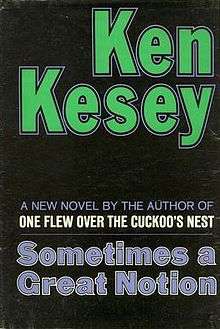Sometimes a Great Notion
 First edition | |
| Author | Ken Kesey |
|---|---|
| Country | United States |
| Language | English |
| Publisher | Viking Press |
Publication date | July 27, 1964 |
| Media type | Print (Hardback and Paperback) |
| Pages | 715 pp |
| OCLC | 71045661 |
| 813/.54 22 | |
| LC Class | PS3561.E667 S6 2006 |
Sometimes a Great Notion is Ken Kesey's second novel, published in 1964. While One Flew Over the Cuckoo's Nest (1962) is arguably more famous, many critics consider Sometimes a Great Notion Kesey's magnum opus.[1] The story involves an Oregon family of gyppo loggers who cut and procure trees for a local mill in opposition to striking, unionized workers.
Kesey took the title from the song “Goodnight, Irene”, popularized by Lead Belly.
Sometimes I lives in the country
Sometimes I lives in town
Sometimes I take a great notion
To jump into the river an’ drown
Plot
The story centers on the Stamper family, a hard-headed logging clan in the fictional town of Wakonda, Oregon in the early 1960s. The union loggers in the town of Wakonda go on strike in demand of the same pay for shorter hours in response to the decreasing need for labor. The Stamper family, however, owns and operates a company without unions and decides to continue work as well as supply the regionally owned mill with all the timber the laborers would have supplied had the strike not occurred.
This decision, and the surrounding details of the decision, are deeply explored in this multilayered historical background and relationship study, especially in its examination of the members of the Stamper Family: Henry Stamper, the old and half-crazed patriarch whose motto "Never Give a Inch!" has defined the nature of the family and its dynamic with the town; Hank, the older son of Henry whose strong will and personality make him a leader but his subtle insecurities and desires threaten the stability of his family; Leland, the younger son of Henry and half brother of Hank, whose constant weaknesses and the nature of his intellect led him away from the family to the East Coast, but whose eccentric behavior and desire for revenge against Hank lead him back to Oregon; and Viv, whose love for her husband Hank fades quickly when she begins to realize her true place in the Stamper household.
The family house itself manifests the physical stubbornness of the Stamper family; as the nearby river widens slowly and causes erosion, all the other houses on the river have either been consumed or wrecked by the waters or moved away from the current, except the Stamper house, which stands on a precarious peninsula struggling to maintain every inch of land with the help of an arsenal of boards, sand bags, cables, and other miscellaneous items brandished by Henry Stamper in his fight against the encroaching river.
Style
Sometimes a Great Notion is more rooted in realism than Kesey's previous work, the phenomenally successful One Flew Over the Cuckoo's Nest, but is also more experimental. It has been compared to William Faulkner's Absalom, Absalom! in both form and content.[2]
The novel's multiple characters speak sequentially in the first person, seemingly without alerting the reader to whom they are listening. While a first reading can be confusing, subsequent readings reveal that Kesey always provides a clue, such as quickly referring to the previously presumed first character in the third person. This technique allows Kesey to weave an intricate braid of characters who reveal their motives in depth to the reader, but do not communicate well with each other.
Reception
Initial reviews of the book ran to both extremes,[3] but its reputation has aged well. Charles Bowden calls it "one of the few essential books written by an American in the last half century."[4] In 1997, a panel of Northwest writers voted it number one in a list of "12 Essential Northwest Works".[5] One book critic has described it as "what may well be the quintessential Northwest novel".[6]
Film adaptation
In 1970, the novel was adapted into a film, which was also marketed under the name Never Give An Inch. The film was directed by Paul Newman, who starred alongside Henry Fonda. It was nominated for two Oscars.
Stage adaptation
A stage adaptation, written and directed by Aaron Posner, premiered in Portland, Oregon at Portland Center Stage on April 4, 2008.
Notes
- ↑ Bowden 2006, pg. xv
- ↑ Cengage, Gale (1976), Ken Kesey 1935–, Contemporary Literary Criticism
- ↑ Wolfe 1969, pg. 102
- ↑ Bowden 2006, pg. xiii
- ↑ Marshall, John (1997-08-10), Books Convey the Spirit of Northwest, The Spokesman-Review
- ↑ Marshall, John (2001-11-16), Ken Kesey's true legacy is 'Sometimes a Great Notion', Seattle Post-Intelligencer
References
- Bowden, Charles. (Introduction to) Kesey, Ken. Sometimes a Great Notion (2006) Penguin. ISBN 0-14-303986-5
- Wolfe, Tom. The Electric Kool-Aid Acid Test (1969) Farrar, Straus and Giroux. ISBN 0-312-42759-X
.jpg)